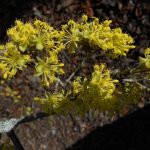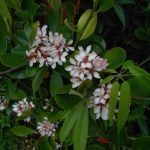The forecast New Year’s Day storm did not materialise, allowing the Castle fireworks to herald in the start of 2014 with a great colourful spectacle. Storms blew in during the following days resulting in the Garden closing on Friday 3rd. One casualty of the high winds has been squirrel drays; I have never seen so many fallen to the ground. Despite the storms the relatively mild weather continued, yet on the night of the 5th a frost slipped in and whitened the lawns.
With only sporadic frosts through November/December 2013 to mid-January 2014 it was not surprising that tomatoes remaining on the vine in the lean to glasshouse on the west facing wall of the Fletcher Building were still edible.
As the weather forecasters said “January was an unseasonably mild month”. We took a picking of spinach from unprotected overwintered plants at home.
Here in the Garden mowing continued through the winter. Machines were out in both December 2013 and January 2014 topping the sward to maintain the appearance of fine turf!
Edinburgh’s rainfall was below average and consequently we did not suffer from the flooding events occurring in other parts of the country which dominated the news through all of January. In retrospect the most benign winter I have experienced. Very few days of frost and only a smidging of snow here in Edinburgh. We used very little salt and grit on the garden roads this winter.
The second week in March saw a settled dry spell with sunshine, just coinciding with the Cornus mas flowering. The heat from the sun bringing out the scent from this deciduous multi-branched small tree. The previous weekend English strawberries were on sale in the supermarkets; a week earlier than last year.
Dawn on Monday 24th March introduced the whitest and coldest frost of the winter, just as the Camellias and Rhododendrons commenced flowering. The early bright sun took the colour out of the petals as the thaw was so rapid. Having said that we experienced the best season in memory for Rhododendron blossom due to the mild winter weather and no frosts to speak of during the later peak flowering season.
Laburnum trees were laden with golden chains this May. In addition, leaving the garden on Friday 16th May with the sun shining and the temperature just touching 21oc the scent from the long pendulous flower trusses of the Wisteria, another member of the family Leguminosae, growing against the south facing wall in the yard was filling the air. Flowers were observed on other woody species such as Rhaphiolepis x delacourii, an evergreen shrub that previously had not been known to bloom so prolifically in the Garden.
Rhubarb however did not appreciate the weather with less growth and the consequent crumbles on the dining table were fewer than from the lush repeated growth of rhubarb stalks during the cooler, wetter spring of 2013.
This was the warmest spring in Scotland on record with the month of May and the previous 5 months all above the average temperature.
Sudden torrential rainstorms of May were followed by sunshine, and long evenings with bright light.
June and the short torrential rain storms continued. However an anticyclone sat to the NW of Scotland and gave us a week of heat and stillness for midsummer. As usual the Garden remained open until 10.30pm on the longest day and we were inundated with visitors, queues formed to walk through the Front Range. Visitors enjoyed the evening with acrobats in the trees and stilt walkers on the ground.
The smell of creosote liquefying from old wooden sleepers stored in the nursery was an indicator of the heat rising and settling in the mid 20’s. Bees were everywhere, taking advantage of the prime flowering season.
The Poppy meadow cultivated on the front lawn as a memorial to the 100 years since Britain entered the First World War in 1914 was well admired. The meadow also attracted masses of pollinating insects. Flowers continued to be produced on the Cornflower until the frosts of the second week of December.
By mid-August the weather had changed, a drop in temperature and even a warning of the risk of hypothermia for walkers and climbers from the Mountaineering Council of Scotland. In the Garden, suddenly, it was topcoat weather.
September was one of the driest for decades, autumn colours commenced early due to the dry soil around the root zones. From the 20th September the Conkers started falling, an exceptionally plentiful crop this year likewise of Beech mast. These distinctive shaped nuts plumped up well. They have a good taste if you can be bothered to split the husk open. Yet, the Sweet Chestnuts were, as usual, their small insignificant shells with no filling. No opportunity for a roasting from our trees. Michaelmas Daisies have also appreciated the September weather. Very little rain fell to spoil the colour of these composites.
Opening the south facing metal clad shed doors mid-morning at the tail end of September, I burnt my hand; the heat from the sun had been so intense, absorbing into the metal.
On the morning of 2nd October the air felt much cooler, even traces of a ground frost on the front lawn where cool air had accumulated during the night. A plant that I remember as winter flowering during the 1970’s; Viburnum x bodnantense was not only providing a good show of colour at this early date but also exuding a powerful scent in the cooler air.
Snow fell overnight on the 7/8th December giving the Pentland Hills a covering. With freezing temperatures at the Garden we had a covering of ice on the paths but no snow. The “weather bomb” that caused disruption on the west coast resulted in the Garden closing for one and a half days over the 9/10th December. We opened on the 11th having checked the garden for damage to the tree collection only to experience heavy wet snow falling. All is not in retreat though; the white buds of Galanthus ‘Lady Beatrix Stanley’ are evident amongst ground foliage and leaf litter.
It will be interesting to see if the bedding Geraniums still flowering at the back door survives into spring. These are the 2013 plants that suffered no die back last winter and have flowered complacently for 19 months.
Best wishes for 2015. Remember gardens are to be enjoyed for each of the twelve months of the year so plan and plant well for seasonal interest. To make the most of this; wear appropriate warm and waterproof clothing as the prevailing weather conditions dictate. As illustrated by the attached image of a storm blowing through the Garden from the west.



